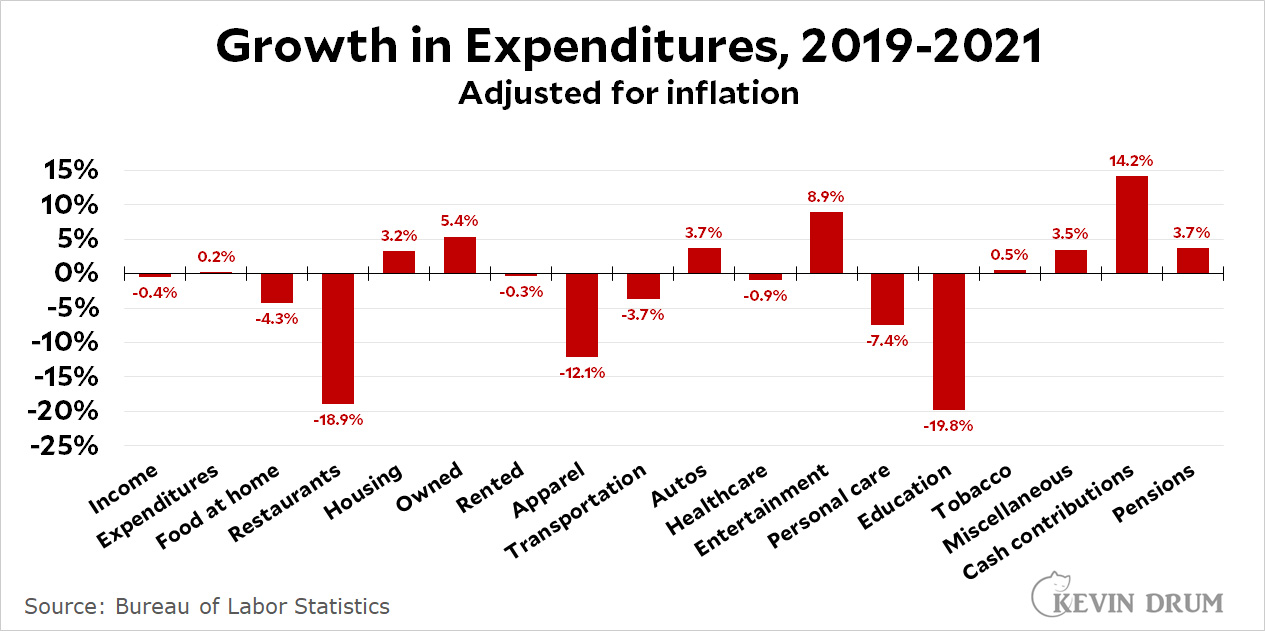From the Consumer Expenditure Survey, here is the growth rate of every product category from 2019 through 2021:
 A little surprisingly, there are several categories that are still way below their pre-pandemic levels: restaurants, apparel, personal care, and education.
A little surprisingly, there are several categories that are still way below their pre-pandemic levels: restaurants, apparel, personal care, and education.
I understand why restaurants and education might still be trying to claw their way back up, but what's the deal with apparel and personal care? Why are people still spending way less on clothing than they used to? Is this just a consequence of having fewer cocktail parties and concerts and so forth? I guess we'll find out a year from now when the 2022 numbers are released.

Why are people still spending way less on clothing than they used to?
If you're working remotely you don't need a nice set of Brooks Brothers (or Saint John) suits anymore. The pandemic absolutely decimated the business apparel industry.
Nor do you need your hair coiffed as carefully and as frequently. Zoom hides a lot!
Don't forget Kevin thinks working from home growth was a myth. He won't attribute it to something that he doesn't think is happening.
Rush hour traffic is still way down from pre-pandemic where I live, so I know that WFH is still a thing.
I stopped going to the office in 2020, as did the bulk of our employees. I just looked, I've spent right at $1K on clothes since then. Spent about $3K/year before then. So my clothing spend is down something like 6x.
You can't wear now the clothes you passed up buying during the pandemic - it's too hot for more than one layer.
I assume that expenditures in the second half of 2021 looked very different than they did in Q1 and early Q2 2021.
The pandemic was in full swing in early 2021.
Yes. That's a good point. It's likely some of these sectors have seen considerable improvement in 2022.
The "food at home" decrease is a bit of a head-scratcher. You'd think given the reduction in spending on restaurant food, at minimum there'd be a modest increase in "food at home" spending. I mean, folks gotta eat either way...
Maybe it reflects serious economizing on groceries due to inflation concerns (especially gasoline prices)? But stimulus money was still sloshing around in 2021, and inflation concerns hadn't become too prevalent (IIRC) until the beginning of 2022. Maybe people doing less entertaining at home? It's a mystery.
Doordash.
What are 'cash contributions' and why are they up?
Is it all wingnuts and billionaires giving money to insane freaks and the brutally dim?
Some of us realized it's okay to not go out if you don't want to.
My experience is a good portion of the sole proprietors in the restaurant business just walked away when the pandemic turned ugly.
So in my Midwestern city we’re left with the shit.
So no surprise here that business has not bounced back.
The Arby’s and Steak and Shakes and the likes just aren’t capable.
Apparel is 100% work from home. Just want to say this is a long term trend that was already happening before the pandemic that got accelerated by the pandemic. Downtown SF office vacancy over 20%. Public transportation that is all built to bring people to downtown hubs is also still down. WFO is not going away.
The vacancy rate understates the problem. That rate measures the percentage of office space under lease. But the usage rate of that leased space is way down, too.
Is Kevin serious with this? I mean, it's obvious that fewer people are traveling into workplaces: traffic into downtowns is down, parking lots at office buildings are emptier, public transit use is way down. Clothes for work are more expensive than clothes for just lounging around the house, as evidenced by charities that specialize in collecting suits, ties, dress shoes, etc. for homeless and poor people to wear on interviews (as well as just using ones' eyes whenever you're in a department store and you see T-shirts for $5-10 and dress shirts for $30-100). Ditto for personal care: lounging around the house all day doesn't require shaving or putting on makeup daily, nor does it require elaborate hairstyles or even taking as many showers in a given week.
And it's not hard to theorize that most people's primary reason for getting dressed up everyday is to go into work... so if that's not happening, then it's also not shocking that spending on the items that help people go into office buildings without eliciting judgment from others has gone down too.
Exactly. And even though my office is supposed to be back 60% in the office, most people have noticed that a lot of the time, when you show up, the people you want to interact with aren't in that day. So, the real number is probably about 25% back in the office.
This may creep up as managers figure out that they have to really plan for a successful 'back to the office' experience, like picking a day or two when everyone should be in. OTOH, who knows if or when that'll happen.